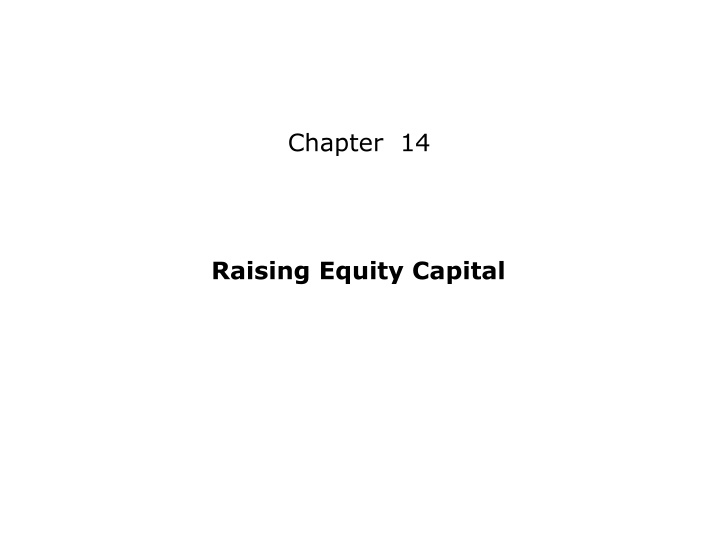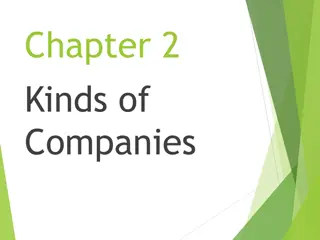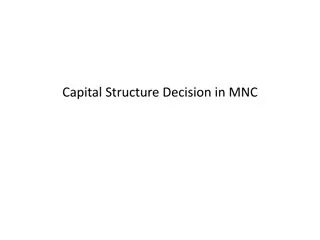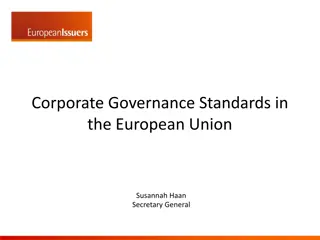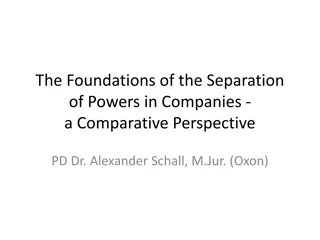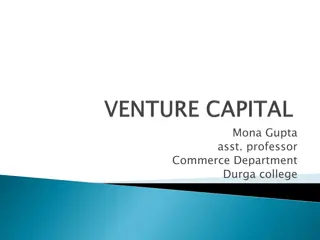Raising Equity Capital for Private Companies: A Comprehensive Guide
Explore the process of raising equity capital for private companies, including sources of funding such as angel investors, venture capital firms, and institutional investors. Get insights into the challenges and strategies involved in taking a company public through an initial public offering (IPO) and raising additional capital post-IPO.
Download Presentation

Please find below an Image/Link to download the presentation.
The content on the website is provided AS IS for your information and personal use only. It may not be sold, licensed, or shared on other websites without obtaining consent from the author.If you encounter any issues during the download, it is possible that the publisher has removed the file from their server.
You are allowed to download the files provided on this website for personal or commercial use, subject to the condition that they are used lawfully. All files are the property of their respective owners.
The content on the website is provided AS IS for your information and personal use only. It may not be sold, licensed, or shared on other websites without obtaining consent from the author.
E N D
Presentation Transcript
Chapter 14 Raising Equity Capital
Chapter 14 Outline 14.1 Equity Financing for Private Companies 14.2 Taking Your Firm Public: The Initial Public Offering 14.3 IPO Puzzles 14.4 Raising Additional Capital: The Seasoned Equity Offering
Learning Objectives Contrast the different ways to raise equity capital for a private company Understand the process of taking a company public Gain insight into puzzles associated with initial public offerings Explain how to raise additional equity capital once the company is public
14.1 Equity Financing for Private Companies Sources of Funding: A private company can seek funding from several potential sources: Angel Investors Venture Capital Firms Institutional Investors Corporate Investors
14.1 Equity Financing for Private Companies Angel Investors: Individual investors who buy equity in small private firms The first round of outside private equity financing is often obtained from angels
14.1 Equity Financing for Private Companies Venture Capital Firms: Specialize in raising money to invest in the private equity of young firms In return, venture capitalists often demand a great deal of control of the company
Figure 14.1 Most Active U.S. Venture Capital Firms in 2009 (by Number of Deals Completed
Figure 14.2 Venture Capital Funding in the United States
14.1 Equity Financing for Private Companies Institutional Investors: Pension funds, insurance companies, endowments, and foundations May invest directly May invest indirectly by becoming limited partners in venture capital firms
14.1 Equity Financing for Private Companies Corporate Investors: Many established corporations purchase equity in younger, private companies corporate strategic objectives desire for investment returns
14.1 Equity Financing for Private Companies Securities and Valuation When a company decides to sell equity to outside investors for the first time, it is typical to issue preferred stock rather than common stock to raise capital It is called convertible preferred stock if the owner can convert it into common stock at a future date
Example 14.1 Funding and Ownership Problem: You founded your own firm two years ago. You initially contributed $100,000 of your money and, in return received 1,500,000 shares of stock. Since then, you have sold an additional 500,000 shares to angel investors. You are now considering raising even more capital from a venture capitalist (VC).
Example 14.1 Funding and Ownership Problem (cont d): This VC would invest $6 million and would receive 3 million newly issued shares. What is the post-money valuation? Assuming that this is the VC s first investment in your company, what percentage of the firm will she end up owning? What percentage will you own? What is the value of your shares?
Example 14.1 Funding and Ownership Solution: Plan: After this funding round, there will be a total of 5,000,000 shares outstanding: Your shares 1,500,000 Angel investors shares 500,000 Newly issued shares 3,000,000 Total 5,000,000
Example 14.1 Funding and Ownership Plan (cont d): The VC is paying $6,000,000/3,000,000=$2/share. The post-money valuation will be the total number of shares multiplied by the price paid by the VC. The percentage of the firm owned by the VC is her shares divided by the total number of shares. Your percentage will be your shares divided by the total shares and the value of your shares will be the number of shares you own multiplied by the price the VC paid.
Example 14.1 Funding and Ownership Execute: There are 5,000,000 shares and the VC paid $2 per share. Therefore, the post-money valuation would be 5,000,000($2) = $10 million. Because she is buying 3,000,000 shares, and there will be 5,000,000 total shares outstanding after the funding round, the VC will end up owning 3,000,000/5,000,000=60% of the firm. You will own 1,500,000/5,000,000=30% of the firm, and the post-money valuation of your shares is 1,500,000($2) = $3,000,000.
Example 14.1 Funding and Ownership Evaluate: Funding your firm with new equity capital, be it from an angel or venture capitalist, involves a tradeoff you must give-up part of the ownership of the firm in return for the money you need to grow. The higher is the price you can negotiate per share, the smaller is the percentage of your firm you have to give up for a given amount of capital.
14.1 Equity Financing for Private Companies Exiting an Investment in a Private Company Acquisition Public Offering
14.2 Taking Your Firm Public: The Initial Public Offering The process of selling stock to the public for the first time is called an initial public offering (IPO)
Table 14.1 Largest Global Equity Issues, 2009
14.2 Taking Your Firm Public: The Initial Public Offering Advantages and Disadvantages of Going Public Advantages: Greater liquidity Better access to capital By going public, companies given their private equity investors the ability to diversify. In addition, public companies typically have access to much larger amounts of capital through the public markets, both in the initial public offering and in subsequent offerings.
14.2 Taking Your Firm Public: The Initial Public Offering Disadvantages: Equity holders more dispersed Must satisfy requirements of public companies When investors sell their stake and thereby diversify their holdings, the equity holders of the corporation become more widely dispersed. Thus undermines investor s ability to monitor the management and thus represents a loss of control. Furthermore, once a company goes public, it must satisfy all of the requirements of public companies. In general, these standards were designed to provide better protection for investors. However, compliance with the new standards is costly and time-consuming for public companies.
14.2 Taking Your Firm Public: The Initial Public Offering IPOs include both Primary and Secondary offerings At an IPO, a firm offers a large block of shares for sale to the public for the first time. The share that are sold in the IPO may either by new shares that raise new capital, known as primary offering, or existing shares that are sold by current shareholders, known as a secondary offering. Underwriters and the Syndicate After deciding to go public, managers of the company work with an underwriter, an investment banking firm that manages the security issuance and design its structure. Underwriter: an investment banking firm that manages the offering and designs its structure Lead Underwriter Syndicate: other underwriters that help market and sell the issue
Table 14.2 International IPO Underwriter Ranking Report for 2007
14.2 Taking Your Firm Public: The Initial Public Offering Valuation Underwriters work with the company to come up with a price Estimate the future cash flows and compute the present value Use market multiples approach Road Show Once an initial price range is established, the underwriters try to determine what the market thinks of the valuation. They begin by arranging a road show, in which senior management and the lead underwriters travel around the country promoting the company and explaining their rational for the offer price to the underwriter s largest customers.
14.2 Taking Your Firm Public: The Initial Public Offering Valuation Underwriters work with the company to come up with a price Estimate the future cash flows and compute the present value Use market multiples approach Road Show Once an initial price range is established, the underwriters try to determine what the market thinks of the valuation. They begin by arranging a road show, in which senior management and the lead underwriters travel around the country promoting the company and explaining their rational for the offer price to the underwriter s largest customers.
14.2 Taking Your Firm Public: The Initial Public Offering Valuation Book Building( ) At the end of the road show, customers inform the underwriters of their interest by telling the underwriters how many shares they may want to purchase. This process for coming up with the offer price based on customer s expression of interest is called book building.
14.2 Taking Your Firm Public: The Initial Public Offering Pricing the Deal and Managing Risk Firm Commitment IPO: the underwriter guarantees that it will sell all of the stock at the offer price Over-allotment allocation, or Greenshoe provision: allows the underwriter to issue more stock, amounting to 15% of the original offer size, at the IPO offer price
14.2 Taking Your Firm Public: The Initial Public Offering Other IPO Types Best-Efforts Basis: the underwriter does not guarantee that the stock will be sold, but instead tries to sell the stock for the best possible price Auction IPO: The company or its investment bankers auction off the shares, allowing the market to determine the price of the stock
14.3 IPO Puzzles Four IPO puzzles: Underpricing of IPOs On average, IPO appear to be underpriced: The price at the end of trading on the first day is often substantially higher than the IPO price. Hot and Cold IPO markets The number of IPOs is highly cyclical. When times are good, the market is flooded with IPOs; when times are bad, the number of IPOs fries up. High underwriting costs The transaction costs of the IPO are very high, and it is unclear why firms willingly incur such high costs. Poor long-run performance of IPOs The long-run performance of a newly public company( three to five years from the date of issue) is poor. That is, on average, a three- to five-year buy and hold strategy appears to be a bad investment.
14.3 IPO Puzzles Underpriced IPOs On average, between 1960 and 2003, the price in the U.S. aftermarket was 18.3% higher at the end of the first day of trading As id evident in Figure 14.5, the one-day average return for IPOs has historically been very large around the world. Note that although underpricing is a persistent and global phenomenon, it is generally smaller in more developed capital markets. Who wins and who loses because of underpricing? Investors vs pre-IPO shareholders
Figure 14.5 International Comparison of First-Day IPO Returns
14.3 IPO Puzzles Hot and Cold IPO Markets It appears that the number of IPOs is not solely driven by the demand for capital. Sometimes firms and investors seem to favor IPOs; at other times firms appear to rely on alternative sources of capital
14.3 IPO Puzzles Hot and Cold IPO Markets Figure 14.6 shows the number of IPOs by year from 1980 to 2009. As the figure makes clear, the dollar volume of IPOs grew significantly in the early 1990s, reaching a peak in 1996. An even more important feature of the data is that the trends related to the number of issues are cyclical. Sometimes, as in 1996, the volume of IPOs is unprecedented by historical standards, yet within a year or two the volume of IPOs may decrease significantly. This cyclicality by itself is not particularly surprising. We would expect there to be a greater need for capital in times with more growth opportunities than in times with fewer growth opportunities.
Figure 14.6 Cyclicality of Initial Public Offerings in the United States, (1980-2009)
14.3 IPO Puzzles High Cost of Issuing an IPO In the U.S., the discount below the issue price at which the underwriter purchases the shares from the issuing firm is 7% of the issue price. This fee is large, especially considering the additional cost to the firm associated with underpricing.
Figure 14.7 Relative Costs of Issuing Securities
14.3 IPO Puzzles Poor Post-IPO Long-Run Stock Performance Newly listed firms appear to perform relatively poorly over the following three to five years after their IPOs That underperformance might not result from the issue of equity itself, but rather from the conditions that motivated the equity issuance in the first place
14.4 Raising Additional Capital: The Seasoned Equity Offering A firm s need for outside capital rarely ends at the IPO Seasoned Equity Offering (SEO): firms return to the equity markets and offer new shares for sale
14.4 Raising Additional Capital: The Seasoned Equity Offering SEO Process When a firm issues stock using an SEO, it follows many of the same steps as for an IPO. Main difference is that the price-setting process is not necessary. Tombstones Historically, underwriters would advertise the sale of stock (both IPOs and SEOs) by taking out newspaper advertisements.
Figure 14.8 Tombstone Advertisement for a RealNetworks SEO
14.4 Raising Additional Capital: The Seasoned Equity Offering Two kinds of seasoned equity offerings: Cash offer the firm s offers the new shares to investors at large. Rights offer the firm s offers the new shares only to existing shareholders.
14.4 Raising Additional Capital: The Seasoned Equity Offering SEO Price Reaction Researchers have found that, on average, the market greets the news of an SEO with a price decline (about 1.5%) Often the value lost can be a significant fraction of the new money raised Adverse selection (the lemons problem)
14.4 Raising Additional Capital: The Seasoned Equity Offering SEO Costs In addition to the price drop when the SEO is announced, the firm must pay direct costs as well. Underwriting fees amount to 5% of the proceeds of the issue
